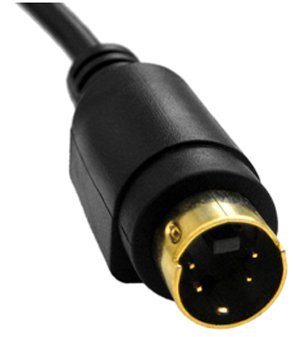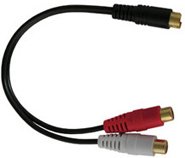In this article we look at S-video signal: what it is, what cables to use, where S-video is used and the problems with it. This is the second in the series of articles outlining the different video signals used in home entertainment for connecting VCRs, DVDs, set top boxes, cameras and laptops to TVs and projectors. In the previous article we looked at Composite Video.
What is S-Video?
S-Video is an improvement on Composite Video as the luma and chroma stay separated. S-Video was introduced with Super VHS Video Cassette Recorders as these higher quality devices recorded the luma and chroma separately on to the video tape. This overcame the problem of having to separate these two components in the TV, as they were already separated (they were not mixed in the first place). By keeping the luma and chroma separate throughout the whole signal path, the resulting picture appears crisper with less colour smear compared to composite video.
The “S” in S-video normally means “Super” video (like Super VHS) or “Separated” video. In a S-video signal, the sync (timing information) is still combined with the luma information. In technical articles, the luma signal (black & white picture information) is represented by the letter “Y”. Chroma (the colour information) is represented by the letter “C”. Hence S-video can also be referred to as Y/C video signal.
Cables to use for S-video
The normal connecter for S-Video uses 4 pins: 2 pins for “Y” (luma) and 2 pins for “C” (chroma). The cable needs to have two separate pairs (4 wires in total). Pre-made S-video cables are normally available in lengths up to 15 metres (50 foot). For longer cables, it is normal to use a breakout cable at each end, and install two RG59 video cables in between.
Please be careful when using a S-video plug, make sure it is orientated the right way as the pins are easily bent if forced in the the wrong way.
Some devices also use a 7 pin socket. A 4 pin S-video plug should plug into a 7 pin socket with the 4 pins connecting to the right sockets containing the luminance and chroma signal.
Where S-video is Used
S-video is not regularly used these days as there are better ways to connect video signals. However it is still widely available on many DVD players, Set Top Boxes (STB) and game consoles. Older laptop computers also have a S-video connector (although often 7 pin).
To connect a screen or projector with a S-video cable, it needs to have a S-video socket, as does the DVD player or STB.
Problems with S-video
Although S-video is better than composite video in that the chroma (colour) and luma (picture content) are separated, there are still problems with S-video. Colour content for video is made up of red, blue and green. In S-video, all this colour information is combined into one signal path and cable and is therefore compromised.
In the next articles we look at RGB video signals, and then component video, where the colour information remains separate.


